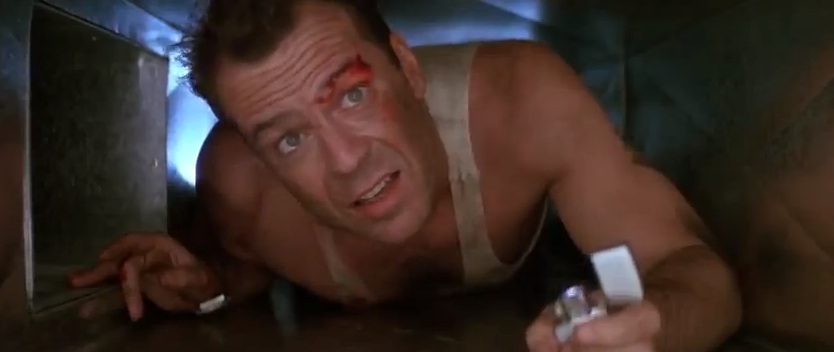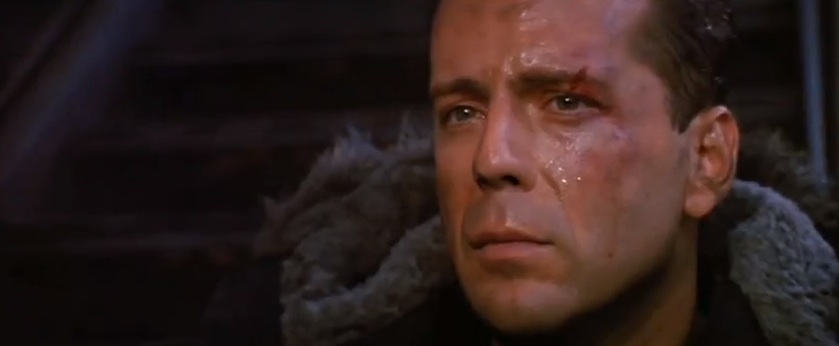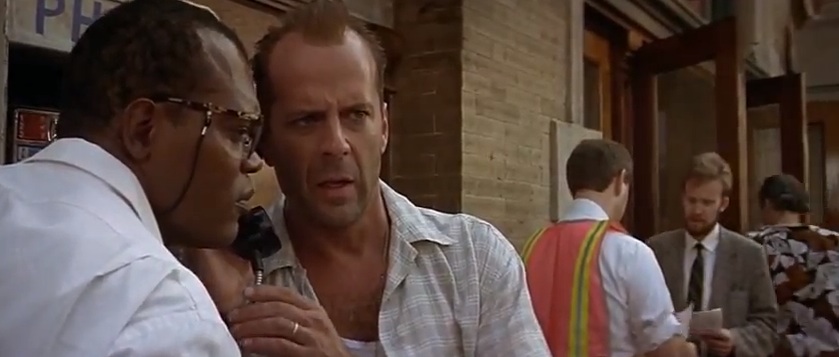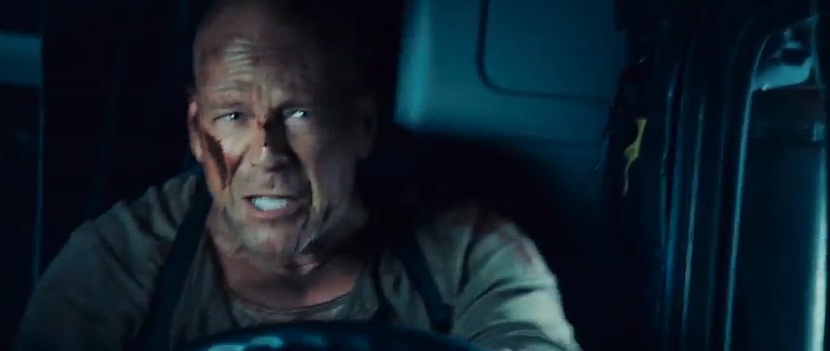Baseball's Active Leaders, 2023
What Trump Said When About COVID
Recent Reviews
Everything Everywhere All at Once (2022)
Black Panther: Wakanda Forever (2022)
Doctor Strange in the Multiverse of Madness (2022)
Spider-Man: No Way Home (2021)
The Cagneys
A Midsummer Night's Dream (1935)
Something to Sing About (1937)
Angels with Dirty Faces (1938)
A Lion Is In the Streets (1953)
Man of a Thousand Faces (1957)
Never Steal Anything Small (1959)
Shake Hands With the Devil (1959)
John McClane — American Hero
Its star was a TV actor unable to parlay his small-screen moment (“Moonlighting”) into big-screen success (“Blind Date,” “Sunset”). Its villain was unknown this side of the Atlantic. One of its writers had done mostly TV (“Lucan,” “Knight Rider”), while the other had no credits to his name. Its source material was a novel, a sequel actually, about an aging detective named Joe Leland visiting his daughter and grandchildren in L.A. It was called “Nothing Lasts Forever” but the filmmakers decided to change the title to something punchier and punnier.
They called it “Die Hard.”
Released in July 1988, it made more than $80 million and spawned an entire sub-genre of movies: “Die Hard” on a boat (“Under Siege”), “Die Hard” on a plane (“Passenger 57”), “Die Hard” on the president’s plane (“Air Force One”). Basically: a group of bad guys take over a small enclosed space, and one good guy, who’s there more or less by accident, tries to stop them.
So what is it about that first “Die Hard” anyway? Why did it work? Why has it become legendary?
Shoeless John
For starters, the grandfather-detective named Joe Leland morphed into a father-cop named John McClane. Everyone can get behind a cop.
He’s about as “regular guy” as you can get. He rides in the front of the limo. He checks out centerfolds while running for his life. He likes Roy Rogers. Hell, he’s the kind of guy who would like “Die Hard.” One wonders if that isn’t a key to success: Would your lead character like the movie he’s in?
They gave him vulnerabilities. He’s tough, but afraid to fly. He smokes, but carries around a giant teddy bear for his kids. Best of all: They take away his shoes. That’s smart. When the shooting starts, he’s still busy in the plush 30th-floor bathroom making “fists with his toes,” as his airplane seat-mate suggested he do to overcome anxiety, and he doesn’t get them back for the rest of the film. It’s a small thing that adds up to a large thing. I remember cringing in the theater when he has to pluck glass shards from the bottom of his bloody feet.
Then they take this one regular guy (without shoes) and stick him between two groups. “Two groups?” you ask. Yes, two groups.
The first group is, of course, a super-efficient international team of terrorists, led by Hans Gruber (Alan Rickman), who was recently voted the 46th greatest villain of all time by the American Film Institute.
These guys are creepy, less because of the glowering silent types like Alexander Gudonov’s Karl, and more because of the ones who whistle while they work, such as Clarence Gilyard, Jr.’s Theo, who helped spawn a generation of onscreen black computer hackers. “Oh my god, the quarterback is toast!” he shouts enthusiastically as the cops’ RV is decimated by a rocket launcher. You seriously want to deck the dude.
The smartest guy in the room is always Hans. “You want money?” Takagi asks incredulously. “What kind of terrorists are you?” “Who said we were terrorists?” Hans responds. When McClane shows up with his HO HO HO message, Hans knows he’s no security guard. Captured, he fakes an American accent and manners. He knows the FBI playbook. He has a classical (read: European) education and fancy (read: European) suits and waxes eloquent on a bankrupt American culture. All of which makes him a perfect foil for McClane and his pop cultural references. “Ehh! Sorry Hans, wrong guess. Would you like to go for Double Jeopardy where the scores can really change?” It’s the wise-ass in the back row making fun of the uptight teacher. Yippee-ki-yay, indeed.

The Greatest American Heroes
One can argue that this wise-ass is actually an amalgamation of three of the most quintessential heroes in American cinema. Numbers 4, 5, and 7 on that AFI list, to be exact.
No. 5 is Marshal Will Kane (Gary Cooper) in “High Noon.” Most of our cinematic heroes are lone gunmen, and Kane is the epitome. He’s the guy trapped between two groups: Frank Miller and his gang, who want revenge on Kane, and the townspeople too cowardly to help. Which is why he’s out there by himself.
Why is John McClane out there by himself? Because he’s trapped between the terrorists who want to kill him, and the townspeople too stupid to help.
Seriously, how many incompetent people are involved in L.A. policework anyway? When McClane finally gets through on an emergency reserve channel, the women on the other end chastise him for using the channel in the first place. Even after they hear gunfire they send only one black-and-white to investigate. Once the cops show up, they blame McClane. Once the FBI shows up they play right into the villains’ hands.
They’re supermacho. They rush in where McClane fears to tread. “An A-7 scenario,” say the FBI Johnsons, misreading the situation. “Kick ass,” says Deputy Police Chief Dwayne Robinson before disaster strikes. “Sprechen sie talk?” says Ellis before getting shot in the head. All of these guys think they’re heroes. They think they can save the situation.
The beauty of John McClane is that he doesn’t. In this sense he’s reminiscent of No. 4 on the AFI list: Rick Blaine (Humphrey Bogart) in “Casablanca.” There’s a great isolationist streak in the American psyche and Rick epitomizes it. “I stick my neck out for nobody,” he says famously. Then the world goes to hell and he has to get involved.
Ditto McClane. If Hans just opens the front door, he’ll leave. The L.A. cops tell him to lie low and he’s more than willing. But things keep going wrong. The bad guys are superefficient and everyone else is superincompetent, and there he is, stuck in the middle with a machine gun. Plus Holly, his wife, is down there. Even if she won’t take his name.
So how does this one regular guy without shoes beat 12 superefficient terrorists when he doesn’t want to be there and none of the townspeople are smart enough to help him? He wins the way Rocky Balboa (AFI’s No. 7) wins. He gets hit and doesn’t go down. He endures. Subsequent “‘Die Hard’ in a...” movies starred martial artists like Steven Segal and Wesley Snipes, people with specialized knowledge, but McClane knows nothing special.
All of which goes to the heart of who American men believe themselves to be. We’re not smart. We’re not talented. We can’t keep our wives in check. We don’t even want to be here. But when the shit hits the fan, yeah, what the hell. Since nobody else is doing anything.

And the rest
Unfortunately, the sequels began to take away the things that made “Die Hard” work.
First, they aren’t even “‘Die Hard’ in a...” movies since John McClane is never trapped in a small enclosed space. In the second film he’s got the run of Dulles Airport and its D.C. environs. In the third film he’s racing all over New York and Canada. In the fourth he's all up and down the eastern seaboard. In the fifth, he goes abroad. You lose focus and intimacy this way: the sense that hero and villain are right next to each other, breathing down each other’s necks.
I guess they had to give back his shoes (it would’ve looked silly if he kept losing them), but did they have to give back Rick Blaine? In “Die Hard 2,” McClane isn’t the reluctant hero; he’s the guy who rushes in. Look, those guys pushed that suitcase under the table. I guess I’ll follow them.
He’s still surrounded by superincompetents (Dennis Franz, et al.), but for the requisite face-to-face with the villains the film relies on fantastic coincidences (McClane bumping into Col. Stuart at the airport) and inconceivable betrayals (Major Grant). Plus every time he’s ready to step down, Barnes (Art Evans) tells McClane — rather than, say, anyone in authority — the specialized information to get near the bad guys. Don’t even get me started on the snowmobile chase.
In the third film, “Die Hard with a Vengeance,” McClane also loses the Will Kane connection. He’s no longer the lone gunman trapped between two groups. For the first time we see him with his group, New York cops, and they’re a pretty smart, cynical bunch. It seems more realistic, less cartoonish, but it leaves him with just one cinematic role model: Rocky. Maybe that’s why the film feels punchdrunk.
The betrayals become more inconceivable. Holly leaves him again? After he saved her life twice? Makes you wonder what a guy’s gotta do to keep a girl.
The coincidences become more fantastic. OK, so the villains flood the tunnel where McClane is driving the gold-laden truck and he climbs on top of the truck and grabs onto a ladder that leads to the surface, but is pushed by the water, geyser-like, up the shaft and into the middle of a park, and isn’t killed or even seriously injured. Sure, why not? It’s an action movie. But his partner, Zeus (Sam Jackson), just happens to be driving by at that very second?
Don’t even get me started on the clue on the bottom of the bottle of aspirin.

Like Hans
In the most recent versions, McClane isn’t even a regular guy anymore. He’s the special guy. He’s the guy who keeps surviving these incredible adventures. “Have you done stuff like that before?” Justin Long asks him, amazed, in “Live Free or Die Hard.” “I guess you’ve done this before,” a Russian says to him in “A Good Day to Die Hard,” to which his son, John, Jr., replies, “Don’t encourage him.”
But we do. Why a fifth installment? Because for all of the memorable movies Willis has made in the 21st century--“Unbreakable,” “Grindhouse,” “Moonrise Kingdom,” “Looper”--none has grossed as well as the forgettable fourth installment of “Die Hard.” The series is living up to its title. It’s not going away. In this manner, it’s become like Hans. “You want money?” Yes. Yes, it does.

--This article was originally published, in slightly different form, on June 25, 2007 on MSNBC.com.







